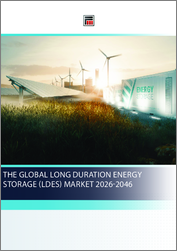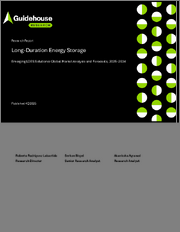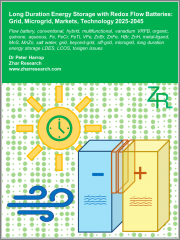
|
시장보고서
상품코드
1742157
세계의 장기 에너지 저장(LDES) 시장(2026-2046년)The Global Long Duration Energy Storage (LDES) Market 2026-2046 |
||||||
세계의 장기 에너지 저장(LDES) 시장은 광범위한 에너지 전환 중 가장 빠르게 진화하고 있는 전략적으로 중대한 부문 중 하나입니다. 4시간 이상 전기를 방전할 수 있는 저장 시스템으로 정의되는 LDES 기술은 그리드 안정성과 신뢰성을 유지하면서 가변 재생 에너지원의 높은 침투 수준을 가능하게 하는 필수 인프라 구성 요소로 떠오르고 있습니다. 시장 성장 촉진요인은 재생 가능 에너지 전개의 가속, 기술 코스트의 저하, 주요 시장 전체 에서의 지지 적인 정책 틀입니다.
현재는 양수발전이 주류이지만, 압축공기에너지저장, 플로우전지, 철공기 배터리, 액체공기에너지저장 등 신기술이 급속히 보급되고 있습니다.
LDES 부문은 엄청난 투자 흐름을 이끌었으며 2024년 동안 벤처 캐피탈이 21억 달러, 기업 투자가 18억 달러, 정부 자금이 12억 달러에 이르렀습니다. 주목할 만한 발전으로는 100시간 지속 능력을 달성한 폼 에너지의 철공 시스템, 상업용 규모에 도달한 에너지 볼트의 중력 저장 장치, 유틸리티 규모의 생존 가능성을 입증하는 하이뷰 파워의 액체 공기 시스템 등이 있습니다. LDES 시장은 강력한 성장이 예상되는 한편, 높은 선행 투자 비용, 기술의 확장성에 대한 우려, 장기 저장 서비스에 대한 보상이 불충분한 규제 틀 등, 큰 과제에 직면하고 있습니다. 이점의 향상과 시장 설계의 진화로 인해 이러한 장벽이 점차적으로 해결되고 있습니다.
LDES 시장은 기술적 성숙이 긴급 탈탄소화의 요구와 융합하는 변곡점에 있으며, 세계의 에너지 전환의 기초가 되는 기술로 자리매김하고 있습니다. 따라서 LDES 솔루션은 그리드 안정성 유지, 계절 에너지 저장 실현, 전례 없는 규모의 태양광 발전 및 풍력 발전 통합을 지원하는 데 필수적이 되고 있습니다.
이 보고서는 세계 장기 에너지 저장(LDES) 시장에 대한 조사 분석을 통해 9개의 주요 저장 기술에 대한 시장 역학, 기술 진화, 경쟁 포지셔닝 및 투자 기회에 대한 정보를 제공합니다.
목차
제1장 주요 요약
- 기술경로
- LDES에 자금 제공
- 용량
- LDES 기술 시장 점유율 : 용량별(2024년)
- 로드맵(2026년-2046년)
- 시장 예측(2026년-2046년)
제2장 소개
- 시장 정의와 기술 분류
- 장기 에너지 저장이란
- 에너지 저장 기술 분류
- 에너지 저장 기술의 벤치 마크
- 전력 및 에너지의 분리
- 안전상의 우려
- LDES에 있어서의 리튬 이온 전지
- LDES 고객
- 기술 준비도
- 기간의 기준치와 기술적 정의
- LDES와 단기저장의 비교
- 가치제안과 경제적 촉진요인
- 기술 성능 요건
- 그리드의 안정성 유지
- 용도
- 시장 부문 : 그리드 스케일, 상업, 비욘드 그리드
- 시장 발전의 억제요인과 제한
- 기술 타임라인
제3장 LDES 시장
- LDES와 변동성 재생 가능 에너지의 통합
- 시장 규모
- 용도
- 그리드의 안정성, 유연성, 통합
제4장 수소와 대체 캐리어
- 수소경제 개요
- 장기적인 저장에 대한 기간의 우위성
- 암염 공동, 해저, 대규모 저장 옵션
- 수소 손실의 메커니즘과 완화 전략
- 하이브리드 수소 전지 시스템
- 대체 화학 캐리어
- 프로젝트와 상업 전개
- 광업
- 주택, 상업용 수소
- 산업용 수소 LDES 통합
- 수소 저장 기술과 인프라
제5장 양수 발전 에너지 저장 기술
- 종래식 양수 발전(PHES)
- 선진 양수 발전(APHES)
제6장 기계적 에너지 저장 기술
- 압축공기 에너지 저장(CAES)
- 고체 중력 에너지 저장(SGES)
- 액화 가스 에너지 저장(LGES)
- 플라이휠 에너지 저장(FES)
제7장 LDES용 전지 기술
- 선진 종래식 구조 전지(ACCB)
- 금속공기 배터리기술
- 고온 전지 시스템
- 나트륨 이온
- 나트륨 유황(Na-S) 전지
- 산화환원 플로우 배터리(RFB)
- 특수 전지 기술
제8장 열에너지 저장
- 기술 개요
- 용도
- 열에너지 저장 시스템 설계
- 축열 시스템의 유형
- 용융염과 콘크리트의 비교
- TRL
- 전열 에너지 저장(ETES)
- 기술 접근
- 첨단 ETES 기술
- SWOT 분석
- 기업
제9장 시장 예측과 기술 로드맵(2026년-2046년)
- 세계 LDES 시장 매출 예측(2026년-2046년)
- 설비 용량의 예측 : 지역별
- 연간 수요 : 국가 / 주별(GWh)(2022년-2046년)
- 연간 설비 용량 : 기술별(GWh)(2022년-2046년)
- 시장 매출 :기술별(2026년-2046년)
- 시장 점유율 분석 : 지역별
- 기간 부문의 성장 예측
- 장기적인 시장의 진화
제10장 기업 프로파일(기업 94사의 프로파일)
제11장 참고문헌
SHW 25.06.17The global Long Duration Energy Storage (LDES) market represents one of the most rapidly evolving and strategically critical segments within the broader energy transition landscape. Defined as storage systems capable of discharging electricity for four or more hours, LDES technologies are emerging as essential infrastructure components for enabling high penetration levels of variable renewable energy sources while maintaining grid stability and reliability. Market growth is driven by accelerating renewable energy deployment, declining technology costs, and supportive policy frameworks across major markets. Total installed LDES capacity is expected to expand from 2.4 GW in 2024 to 18.5 GW by 2030, with project counts increasing from 145 to over 850 installations globally.
Pumped hydro storage currently dominates, however, emerging technologies are rapidly gaining traction, including compressed air energy storage, flow batteries, iron-air batteries, and liquid air energy storage. Gravity storage systems, green hydrogen, and thermal storage represent innovative approaches addressing specific market niches and duration requirements.
The LDES sector has attracted substantial investment flows, with $2.1 billion in venture capital, $1.8 billion in corporate investment, and $1.2 billion in government funding during 2024. This capital is fueling rapid technological advancement and commercial deployment across multiple technology pathways. Notable developments include Form Energy's iron-air systems achieving 100-hour duration capabilities, Energy Vault's gravity storage reaching commercial scale, and Highview Power's liquid air systems demonstrating utility-scale viability. Despite strong growth prospects, the LDES market faces significant challenges including high upfront capital costs, technology scalability concerns, and regulatory frameworks that inadequately compensate long-duration storage services. However, accelerating learning curves, improving economics of scale, and evolving market designs are progressively addressing these barriers. The sector's evolution toward technology hybridization and system integration is creating new opportunities for optimized performance across multiple grid services and applications.
The LDES market stands at an inflection point where technological maturation converges with urgent decarbonization imperatives, positioning it as a cornerstone technology for the global energy transition.
"The Global Long Duration Energy Storage Market 2026-2046" provides an authoritative analysis of the LDES landscape from 2026 to 2046, examining market dynamics, technology evolution, competitive positioning, and investment opportunities across nine primary storage technologies. As variable renewable energy penetration increases globally, LDES solutions are becoming indispensable for maintaining grid stability, enabling seasonal energy storage, and supporting the integration of solar and wind power at unprecedented scales.
Contents include:
- Market Definition and Technology Framework:
- Comprehensive LDES definition with duration thresholds and technical specifications
- Technology classification system covering nine primary LDES categories
- Value proposition analysis and economic drivers for each application segment
- Performance requirements mapping across grid-scale, commercial, and beyond-grid applications
- Market development constraints, limitations, and risk factor assessment
- LDES Market Analysis and VRE Integration:
- Variable renewable energy penetration analysis and storage duration requirements
- Global VRE generation trends with regional breakdown and integration challenges
- Market timing analysis for LDES technology adoption based on renewable deployment
- Comprehensive market sizing with growth projections and capacity deployment forecasts
- Regional project distribution analysis covering commercial and demonstration scale projects
- Applications and Grid Integration:
- Energy storage applications across utility, behind-the-meter, and remote deployment scenarios
- Grid services analysis including ancillary services and grid support functions
- Supply-side and demand-side flexibility solutions with LDES integration strategies
- Renewable curtailment mitigation and system overbuild management approaches
- Vehicle-to-grid integration, smart charging, and distributed energy resource coordination
- Hydrogen and Alternative Carriers:
- Hydrogen economy overview with duration advantages for long-term storage
- Salt cavern, subsea, and large-scale storage infrastructure analysis
- Hydrogen loss mechanisms, mitigation strategies, and hybrid system integration
- Alternative chemical carriers comparison (hydrogen vs methane vs ammonia)
- Underground storage technologies, interconnector systems, and safety considerations
- Pumped Hydro Energy Storage:
- Conventional PHES analysis covering types, environmental impact, and global projects
- Advanced pumped hydro technologies including pressurized underground systems
- Mine storage applications, heavy liquid systems, and seawater pumped hydro
- Underwater energy storage solutions and brine storage in salt caverns
- Economic modeling, financial analysis, and SWOT assessment
- Mechanical Energy Storage Technologies:
- Compressed Air Energy Storage (CAES) technology overview and market positioning
- CAES vs LAES comparison with thermodynamic cycle optimization analysis
- Solid Gravity Energy Storage (SGES) applications and market potential
- Liquefied Gas Energy Storage including liquid air and liquid CO2 systems
- Technology-specific SWOT analyses and competitive positioning assessment
- Battery Technologies for LDES:
- Advanced conventional construction batteries for beyond-grid applications
- Metal-air battery technologies including iron-air, zinc-air, and aluminum-air systems
- Rechargeable zinc batteries covering zinc-ion, zinc-bromine configurations
- High-temperature battery systems and advanced metal-ion technologies
- Redox Flow Batteries (RFB) market analysis with regular vs hybrid technology comparison
- Thermal Energy Storage:
- Electro-thermal energy storage (ETES) fundamentals and application analysis
- Advanced ETES technologies with extreme temperature and photovoltaic conversion
- Combined heat and electricity systems with performance optimization strategies
- Technology SWOT analysis and market positioning assessment
- Market Forecasts and Long-Term Evolution:
- Global LDES market value forecasts with regional capacity installation projections
- Grid vs beyond-grid market development analysis with technology-specific growth patterns
- Annual demand and installation forecasts by country, state, and technology category
- Long-term market evolution including technology convergence, hybridization trends
- Cost competitiveness timelines, market saturation analysis, and emerging applications
The report features comprehensive profiles of 94 companies across the LDES ecosystem including 1414 Degrees, ALCAES, Ambri, Antora Energy, Augwind Energy, AZA Battery, BASF, Battolyser Systems, Brenmiller Energy, Cavern Energy, CellCube, CGDG, Cheesecake Energy, CMBlu, Corre Energy, Dalian Rongke Power, e-Zinc, Echogen Power Systems, Electrified Thermal Solutions, Elestor, Energy Dome, Energy Vault, EnergyNest, Enerpoly, Enervenue, Enlighten Innovations, EnerVenue, EOS Energy Enterprises, Equinor, ESS Inc., Fluence, Form Energy, Fourth Power, Gelion, Glaciem Cooling Technologies, Gravitricity, Green Gravity, H2 Inc., Highview Power, InLyte Energy and more.....
TABLE OF CONTENTS
1. EXECUTIVE SUMMARY
- 1.1. Technology Pathways
- 1.2. Funding for LDES
- 1.3. Capacity
- 1.4. LDES Technology Market Share by Capacity (2024)
- 1.5. Roadmap 2026-2046
- 1.6. Market Forecasts and Projections 2026-2046
- 1.6.1. Total LDES Market Revenues
- 1.6.2. Regional Market
2. INTRODUCTION
- 2.1. Market Definition and Technology Classification
- 2.2. What is Long Duration Energy Storage?
- 2.3. Energy Storage Technology Classification
- 2.4. Energy Storage Technology Benchmarking
- 2.5. Power and Energy Decoupling
- 2.6. Safety considerations
- 2.7. Lithium-ion batteries in LDES
- 2.8. LDES customers
- 2.9. Technology Readiness Level
- 2.10. Duration Thresholds and Technical Definitions
- 2.11. LDES vs Short Duration Storage Comparison
- 2.12. Value Proposition and Economic Drivers
- 2.13. Technology Performance Requirements
- 2.14. Maintaining Grid Stability
- 2.15. Applications
- 2.16. Market Segments: Grid-Scale, Commercial, Beyond-Grid
- 2.17. Market Development Constraints and Limitations
- 2.18. Technology Timeline
3. LDES MARKET
- 3.1. LDES and Variable Renewable Energy Integration
- 3.1.1. Variable Renewable Energy (VRE) Penetration and Storage Duration Requirements
- 3.1.2. Global VRE Generation Trends
- 3.1.3. Relationship between VRE penetration and storage requirements
- 3.1.4. The global electricity generation mix
- 3.1.5. Early LDES Technologies Adoption
- 3.1.6. Storage Duration vs VRE Penetration
- 3.2. Market Size
- 3.2.1. Global LDES Market Size and Growth Projections
- 3.2.2. Capacity Deployment by Technology
- 3.2.3. Regional Project Distribution and Development
- 3.2.4. Commercial vs Demonstration Scale Projects
- 3.3. Applications
- 3.3.1. Energy Storage Applications
- 3.3.2. Grid Services and Utility
- 3.3.3. Behind-the-Meter
- 3.3.4. Beyond-Grid and Remote Applications
- 3.3.5. Ancillary Services and Grid Support Functions
- 3.4. Grid Stability, Flexibility and Integration
- 3.4.1. Grid Flexibility Requirements and Solutions
- 3.4.2. Supply-Side and Demand-Side Flexibility Options
- 3.4.3. Renewable Curtailment and System Overbuild
- 3.4.4. Interconnector Technologies
- 3.4.4.1. Cable Designs
- 3.4.4.2. Installation and Maintenance
- 3.4.4.3. Companies
- 3.4.5. Vehicle-to-Grid Integration and Smart Charging
- 3.4.5.1. Vehicle-to-Grid and Grid-to-Vehicle
- 3.4.5.2. Vehicle-to-Everything (V2X)
- 3.4.5.3. Grid integration of V2G technologies
- 3.4.5.4. Bi-directional charging infrastructure
- 3.4.5.5. Smart Charging Implementations
- 3.4.5.6. Electric vehicle charging infrastructure
- 3.4.6. Distributed Energy Resources and Virtual Power Plants
- 3.4.7. Hydrogen Production for Grid Flexibility
4. HYDROGEN AND ALTERNATIVE CARRIERS
- 4.1. Hydrogen Economy Overview
- 4.2. Duration Advantages for Long-Term Storage
- 4.3. Salt Caverns, Subsea and Large-Scale Storage Options
- 4.4. Hydrogen Loss Mechanisms and Mitigation Strategies
- 4.5. Hybrid hydrogen-battery systems
- 4.6. Alternative Chemical Carriers
- 4.6.1. Hydrogen vs Methane vs Ammonia for LDES
- 4.6.2. Comparative Analysis of Chemical Storage Options
- 4.6.3. Synthesis and Reconversion Efficiency
- 4.7. Projects and Commercial Deployments
- 4.8. Mining Industry
- 4.9. Residential and Commercial Hydrogen
- 4.10. Industrial Hydrogen LDES Integration
- 4.11. Hydrogen Storage Technologies and Infrastructure
- 4.11.1. Industrial integration applications
- 4.11.2. Remote and off-grid applications
- 4.11.3. Outlook for hydrogen in LDES applications
- 4.11.4. Hydrogen Storage Options for LDES
- 4.11.5. Underground Storage Choices for LDES Applications
- 4.11.6. Hydrogen Interconnectors for Energy Transmission
- 4.11.7. Surface Storage Systems and Safety Considerations
- 4.11.8. Metal Hydride and Alternative Storage Methods
5. PUMPED HYDRO ENERGY STORAGE TECHNOLOGIES
- 5.1. Conventional Pumped Hydro Energy Storage (PHES)
- 5.1.1. PHES Types and Development Timescales
- 5.1.2. PHES Environmental Impact Mitigation Technologies
- 5.1.3. Global Projects and Development
- 5.1.4. Economics and Financial Modeling
- 5.1.5. Large-Scale Pumped Hydro Schemes
- 5.1.6. SWOT Analysis
- 5.2. Advanced Pumped Hydro Energy Storage (APHES)
- 5.2.1. Technology Overview
- 5.2.2. Technologies
- 5.2.2.1. Pressurized Underground Systems
- 5.2.2.2. Underground Mine Pumped Storage
- 5.2.2.3. Heavy Liquid Systems
- 5.2.2.4. Seawater Pumped Hydro (S-PHES)
- 5.2.2.5. Underwater Energy Storage
- 5.2.2.6. Brine Storage in Salt Caverns
- 5.2.3. SWOT Analysis
- 5.2.4. Companies
6. MECHANICAL ENERGY STORAGE TECHNOLOGIES
- 6.1. Compressed Air Energy Storage (CAES)
- 6.1.1. Technology Overview
- 6.1.2. CAES Applications
- 6.1.3. CAES vs LAES
- 6.1.4. Technology Options
- 6.1.5. Thermodynamic Cycles and Performance Optimization
- 6.1.6. Isochoric vs Isobaric Storage Systems
- 6.1.7. Adiabatic Systems and Cooling Options
- 6.1.8. Supercritical CAES
- 6.1.9. Companies
- 6.1.10. SWOT Analysis
- 6.2. Solid Gravity Energy Storage (SGES)
- 6.2.1. Technology Overview
- 6.2.2. Applications
- 6.2.3. SWOT Analysis
- 6.3. Liquefied Gas Energy Storage (LGES)
- 6.3.1. Technology Overview
- 6.3.2. Liquid Air Energy Storage (LAES)
- 6.3.2.1. SWOT Analysis
- 6.3.3. Liquid Carbon Dioxide Energy Storage
- 6.3.3.1. SWOT Analysis
- 6.4. Flywheel Energy Storage (FES)
- 6.4.1. Overview
7. BATTERY TECHNOLOGIES FOR LDES
- 7.1. Advanced Conventional Construction Batteries (ACCB)
- 7.1.1. Technology Overview and Beyond-Grid Applications
- 7.1.2. SWOT Analysis
- 7.2. Metal-Air Battery Technologies
- 7.2.1. Air cathodes
- 7.2.2. Iron-Air Batteries
- 7.2.3. Zinc-based Batteries
- 7.2.3.1. Applications
- 7.2.3.2. Zinc-air (Zn-air)
- 7.2.3.2.1. Properties
- 7.2.3.2.2. Challenges
- 7.2.3.2.3. Companies
- 7.2.3.3. Zn-ion
- 7.2.3.3.1. Overview
- 7.2.3.3.2. Zn-ion and Rechargeable Zn-MnO2 Chemistry
- 7.2.3.3.3. Zn-MnO2 Commercialisation
- 7.2.3.3.4. Zn-ion/Zn-MnO2 Strengths and Weaknesses
- 7.2.3.3.5. Companies
- 7.2.3.4. Zn-Br
- 7.2.3.4.1. Overview
- 7.2.3.4.2. ZnBr Flow Batteries
- 7.2.3.4.3. Static ZnBr Batteries
- 7.2.3.4.4. Companies
- 7.3. High-Temperature Battery Systems
- 7.3.1. High-temperature molten-salt battery systems
- 7.3.2. Commercalization
- 7.4. Sodium-Ion
- 7.4.1. Overview
- 7.4.2. Cathode materials
- 7.4.2.1. Layered transition metal oxides
- 7.4.2.1.1. Types
- 7.4.2.1.2. Cycling performance
- 7.4.2.1.3. Advantages and disadvantages
- 7.4.2.1. Layered transition metal oxides
- 7.4.3. Anode materials
- 7.4.3.1. Hard carbons
- 7.4.3.2. Carbon black
- 7.4.3.3. Graphite
- 7.4.3.4. Carbon nanotubes
- 7.4.3.5. Graphene
- 7.4.3.6. Alloying materials
- 7.4.3.7. Sodium Titanates
- 7.4.3.8. Sodium Metal
- 7.4.4. Electrolytes
- 7.4.5. Comparative analysis with other battery types
- 7.4.6. Application in LDES
- 7.4.7. Large-scale lithium-sodium hybrid energy storage station
- 7.4.8. Companies
- 7.5. Sodium-sulfur (Na-S) batteries
- 7.5.1. Technology description
- 7.5.2. Applications
- 7.6. Redox Flow Batteries (RFB)
- 7.6.1. Market Overview
- 7.6.2. Architecture of redox flow batteries
- 7.6.3. Cost structures
- 7.6.4. RFB vs Li-ion
- 7.6.5. Competitive landscape among redox flow battery technologies
- 7.6.6. All vanadium RFB (VRFB)
- 7.6.7. All-Iron RFB
- 7.6.8. Zinc-Bromine (Zn-Br) RFB
- 7.6.9. Zinc-Iron (Zn-Fe) RFB
- 7.6.10. Alkaline Zn-Ferricyanide RFB
- 7.6.11. RFB for LDES Applications
- 7.6.12. Companies
- 7.6.13. Regular vs Hybrid RFB Technologies and Chemistries
- 7.7. Specialty Battery Technologies
- 7.7.1. Nickel Hydrogen Batteries
- 7.7.2. Aluminum-Sulfur Batteries
- 7.7.3. Silicon Nanowire Batteries
- 7.7.4. Solid-State Electrolyte Batteries
8. THERMAL ENERGY STORAGE
- 8.1. Technology Overview
- 8.2. Applications
- 8.3. Thermal energy storage system design
- 8.4. Types of Thermal Storage Systems
- 8.5. Comparison between molten salt and concrete
- 8.6. TRL
- 8.7. Electro-Thermal Energy Storage (ETES)
- 8.7.1. Applications
- 8.8. Technology approaches
- 8.9. Advanced ETES Technologies
- 8.9.1. Extreme Temperature and Photovoltaic Conversion
- 8.9.2. Combined Heat and Electricity Systems
- 8.10. SWOT Analysis
- 8.11. Companies
9. MARKET FORECASTS AND TECHNOLOGY ROADMAPS 2026-2046
- 9.1. Global LDES Market Value Forecasts (2026-2046)
- 9.2. Capacity Installation Forecasts by Region
- 9.3. Annual Demand by Country/State (GWh) 2022-2046
- 9.4. Annual Installations by Technology (GWh) 2022-2046
- 9.5. Market Value by Technology ($B) 2026-2046
- 9.6. Regional Market Share Analysis
- 9.7. Duration Segment Growth Projections
- 9.8. Long-Term Market Evolution
- 9.8.1. Technology Convergence and Hybridization
- 9.8.2. Cost Competitiveness Timelines
- 9.8.3. Market Saturation and Replacement Cycles
- 9.8.4. Emerging Applications and Use Cases



















